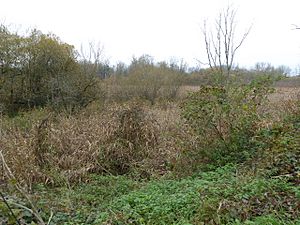Woolhampton Reed Bed facts for kids
| Site of Special Scientific Interest | |
 |
|
| Area of Search | Berkshire |
|---|---|
| Interest | Biological |
| Area | 6.0 hectares (15 acres) |
| Notification | 16985 |
| Location map | Magic Map |
Woolhampton Reed Bed is a special natural area in Woolhampton, Berkshire, in the United Kingdom. It covers about 6 hectares, which is roughly the size of 15 football fields! This place is officially known as a Site of Special Scientific Interest (SSSI).
A Site of Special Scientific Interest is a protected area where plants, animals, or geological features are very important and need to be looked after. These sites are chosen because they have rare wildlife, unique habitats, or interesting rocks and landforms. Woolhampton Reed Bed is protected because of its amazing plants and animals.
| Top - 0-9 A B C D E F G H I J K L M N O P Q R S T U V W X Y Z |
What is Woolhampton Reed Bed?
Woolhampton Reed Bed is mostly made up of thick, tall plants called reeds. Imagine a huge field of tall grass, but even taller and denser! These reed beds grow on a type of soil called London Clay, which is a heavy, sticky clay found in this part of England.
Different Habitats
Even though it's called a "reed bed," this site has a mix of different natural areas:
- Reed Beds: These are the main part, where reeds grow very closely together. They create a perfect home for many insects and birds.
- Carr Woodland: This is a type of wet woodland that grows in boggy or marshy areas. The trees here, like willows and alders, love wet feet!
- Tall Fen: Fens are like marshes, but they get their water from groundwater as well as rain. Tall fens have a variety of tall grasses and other plants that thrive in wet conditions.
This mix of habitats makes Woolhampton Reed Bed a very rich place for different kinds of wildlife.
Amazing Wildlife
Woolhampton Reed Bed is a fantastic place for insects, especially moths and flies. Scientists have spent time here studying and recording all the different species that call this place home.
Moths and Flies Galore
- Moths: Over 300 different kinds of moths have been found here! That's a huge number for one small area. Some of the moths you might find (if you were able to visit) include the obscure wainscot, the burnished brass, and the butterbur moth. Moths are important because they help pollinate plants and are food for other animals like bats and birds.
- Flies: It's not just moths! More than 160 species of flies have also been recorded. Flies might seem annoying sometimes, but they are super important for the environment. They help break down dead plants and animals, pollinate flowers, and are also a food source for many creatures.
The large number of different insect species shows how healthy and important this habitat is.
Why is This Place Special?
Woolhampton Reed Bed is special because it's a great example of a healthy reed bed and wet woodland habitat. These types of places are becoming rarer in the UK, so protecting them is really important. By keeping this area safe, we help make sure that the plants and animals that depend on it can continue to thrive. It's like a natural treasure chest of biodiversity!
Visiting Woolhampton Reed Bed
It's important to know that Woolhampton Reed Bed is on private land. This means there is no public access for visitors. These special sites are often protected to keep them undisturbed so that the wildlife can live safely without being bothered. Even though we can't visit, knowing that places like this exist and are being protected is great news for nature!

